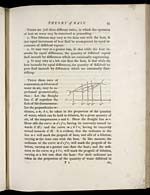James Hutton (1726-1797)
Theory of rain
THEORY of RAIN.
43
THERE are just three different ratios, in which this operation
of heat on water may be conceived as proceeding.
1. THE solution may vary at the same rate with the heat, so
that equal increments of heat shall be accompanied by equal in-
crements of dissolved vapour.
2. IT may vary at a greater rate, so that while the heat in-
creases by equal differences, the quantity of dissolved vapour
shall increase by differences which are continually augmenting.
3. IT may vary at a less rate than the heat, so that while the
heat increases by equal differences, the quantity of dissolved va-
pour shall increase by differences which are continually dimi-
nishing.
[NLS note: a graphic appears here – see image of page]
THESE three rates of
evaporation, or solution of
water in air, may be re-
presented geometrically,
thus: Let the straight
line C H represent the
scale of the thermometer.
Let the perpendicular or-
dinates, a m, b r, be taken in the proportion of the quantity
of water, which can be held in solution, by a given quantity of
air, of the temperatures a and b. Draw the straight line m r.
Draw also the curve m d e f r, having its convexity turned to-
wards C H; and the curve m g k l r, having its concavity
turned towards C H. It is evident, that the ordinates to the
line m r will mark the progress of heat, and also of a solution,
varying at the same rate with the heat. In like manner, the
ordinates to the curve m d e f r, will mark the progress of so-
lution, varying at a greater rate than the heat; and the ordi-
nates to the curve m g k l r, will mark the progress of solution,
varying at a less rate than the heat: For these ordinates are
taken in the proportion of the quantity of water dissolved in
F 2
air,


